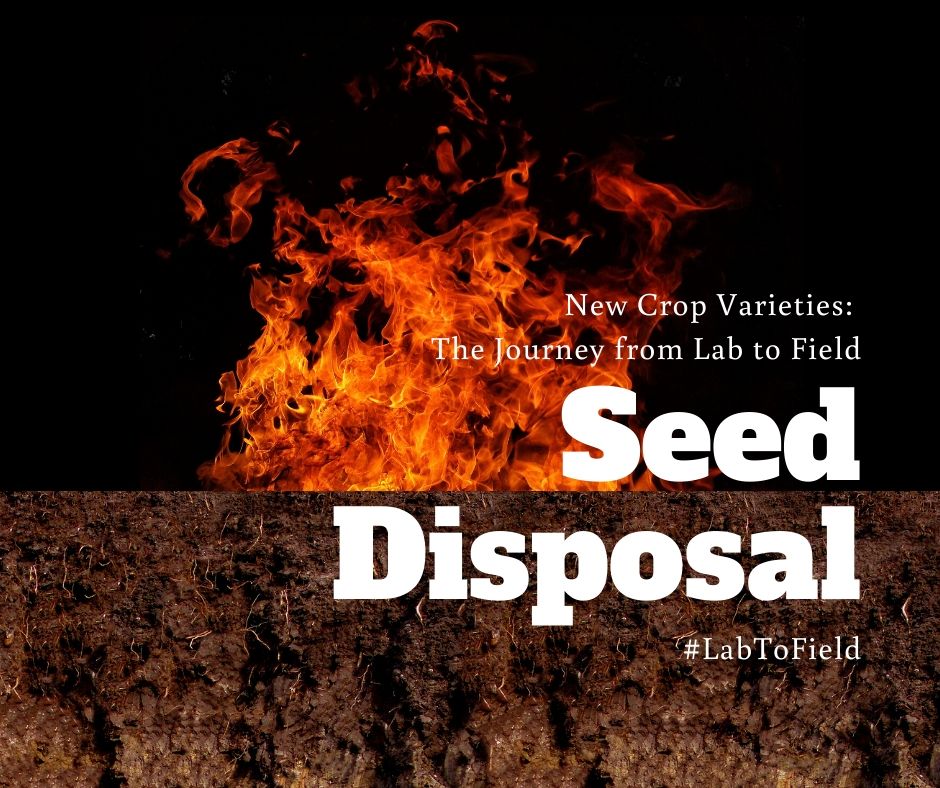This is the eighth of a series of #LabToField blogs that will explain the yearly cycle of variety development. Click here to read Part 1: Phytotrons, Part 2: Agriculture Greenhouses, Part 3: The U of S Seed Lab, Part 4: Seeding, Part 5: Data Collection, Part 6: Harvest, or Part 7: Grains Innovation Lab.
Part 8: Seed Disposal
From the harvested research crops at the Grains Innovation Lab, not all varieties are selected to advance to subsequent breeding generations. Unsuccessful varieties that are inferior or do not contain the desired properties are dropped from the program throughout the winter as further analysis is conducted. These unsuccessful breeding lines must be dealt with somehow. In this blog, we will look at what happens to these seeds that are dropped from the breeding program.
Disposal of Seeds in a Traditional Breeding Program
Throughout the winter, bags of seed wait in piles at the University of Saskatchewan’s Crop Development Centre (CDC) for varietal tests to be conducted. As breeding lines are tested and dropped from the program, their bags are added to the “discard” shelves at the CDC seed lab. Labelled as discard material, these seed samples are kept separate from any material which has been selected to advance to further generations. Come spring, all samples labelled for discard are bulked together into large containers. They are then ground down and sold as livestock feed. This is the case only for seeds bred through traditional methods using crossing techniques, in which no new DNA has been inserted into the plants. In other words, these discard seeds offer no new traits from already existing developed varieties. There is also a low risk of having these seeds released into the natural environment. So, despite these varieties not succeeding in the crop development process, they still provide benefits to the industry as sources of feed and do not create environmental risks.
Disposal of PNT Seeds
For plant trials with novel traits (PNTs), those rejected from the breeding program must be disposed of based on strict CFIA regulations. Since these plants contain traits that may not be present in existing species and are expressed outside the normal range of existing plant species traits, the disposal process is more strictly regulated. These regulations are in place to reduce the risk of these seeds entering the environment. This is also seen in PNT field trials, as they are confined and isolated to reduce the possibility of pollen transferring from the trial plants to others. The trials are also frequently monitored and if outside species appear, they must be destroyed immediately to prevent natural crosses of the plants occurring.
Unlike the disposal of traditional plant breeding materials, rejected PNT seeds cannot be sold for livestock feed. Since environmental assessments of these modified varieties have not yet been conducted by the CFIA, there would be a risk of a second-generation propagation if the seeds were used as feed. No matter how unlikely this is to happen, the CFIA ensures environmental security by a more permanent form of disposal. After harvest, these PNT seeds must be destroyed by an approved method: incineration, burial up to an acceptable depth, or other methods that ensure that the seeds will not be able to grow. In some cases, the CFIA authorizes the seed developers to keep seeds for research in the future, however, these exceptions are uncommon.
It takes generations to find the right one
Thousands of breeding lines exist in the CDC variety development program initially. These lines are a result of generations of selections and varietal testing, ultimately resulting in one or a few varieties that are suitable for commercialization. This means almost all of the lines bred for research end up being discarded throughout the process. For the traditionally-bred varieties, the disposal as animal feed means that waste is minimized by the developers.
From Lab to Field, the end is almost near
As we have discovered throughout this series of blogs, it takes years of work to get from initial crosses in the phytotron and greenhouse to the final selected variety. There are generations grown in field trials, with a multitude of tests and analysis to endure before the varietal selections or disposal is decided. All this is done with the end goal of creating a new crop variety for Canadian farmers.
We have explored the yearly cycle of variety development, but this is not the end of the road for breeders or the variety. After the breeding work and testing is completed, the developers must still apply for registration for the new varieties. The new variety must pass all inspections and assessments as required for registration by the CFIA before it can be registered as a crop variety and the seed can be multiplied to distribute to Canadian farms. In the next, and final blog of this #LabtoField series, we will take a closer look at the processes required for registering a new crop for commercial use.

